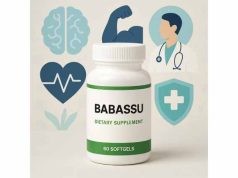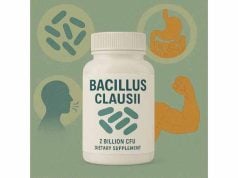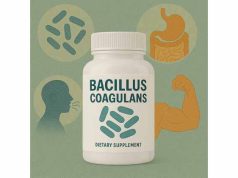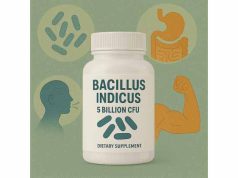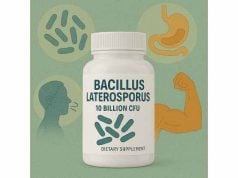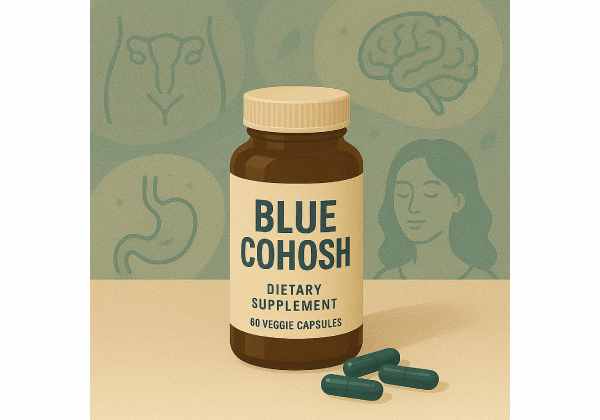
Blue cohosh is a fascinating North American woodland herb with deep roots in Native American and early American herbal traditions. Known for its blue berries and distinctive foliage, blue cohosh (Caulophyllum thalictroides) has long been valued for its effects on women’s health—particularly for menstrual and reproductive wellness. While modern interest in blue cohosh often centers on its potential to ease menstrual cramps, support healthy labor, and address certain hormonal imbalances, it’s essential to understand both the benefits and the risks. This comprehensive guide explores how blue cohosh works, who might consider it, and the critical safety considerations for using this potent botanical wisely.
Key Takeaways
- Blue cohosh is traditionally used to support women’s reproductive health, especially for menstrual and childbirth concerns.
- Contains unique alkaloids and saponins that may influence uterine muscles and circulation.
- Should only be used under professional guidance due to possible side effects and pregnancy risks.
- Not recommended for pregnant women except under direct supervision of a qualified herbalist or healthcare provider.
- Interactions with medications and underlying health conditions are possible—use with caution and consult your provider.
Table of Contents
- Blue Cohosh Introduction: Traditional Uses and Botanical Background
- Active Compounds and Biological Actions of Blue Cohosh
- Evidence-Based Benefits and Modern Applications for Blue Cohosh
- Blue Cohosh Safety, Risks, Side Effects, and Important Interactions
- Blue Cohosh Dosage Guidelines, Usage, and Administration
- Blue Cohosh FAQ: Top User Questions Answered
Blue Cohosh Introduction: Traditional Uses and Botanical Background
Blue cohosh (Caulophyllum thalictroides) is a perennial woodland herb native to the rich forests of eastern North America. Recognizable by its lacy leaves, clusters of small yellowish-green flowers, and round blue berries, the plant’s true value lies in its thick, knobby rhizome—harvested and dried for herbal medicine.
Traditional and Historical Uses
Native American women and early American midwives have used blue cohosh root for generations to:
- Ease difficult menstruation: Alleviate menstrual cramps and regulate cycles.
- Support labor and delivery: Prepare the uterus for childbirth, promote healthy contractions, and reduce the risk of post-birth complications.
- Soothe postpartum discomfort: Aid recovery after childbirth and stimulate uterine cleansing.
- Address women’s hormonal health: Sometimes used for symptoms related to menopause, PMS, or irregular cycles.
Blue cohosh was often prepared as a tea, decoction, or tincture, typically blended with other herbs like black cohosh or raspberry leaf for a more balanced effect. Its reputation as a “woman’s herb” is grounded in centuries of practical observation, but also accompanied by warnings about misuse and overuse.
Modern Herbalism and Use Today
Today, blue cohosh is primarily marketed as a women’s health supplement—most often for:
- Supporting menstrual comfort
- Preparing for labor (sometimes in combination formulas called “partus preparator” blends)
- Menstrual regulation
However, the herb’s potent effects mean it is far less commonly used than in the past, and always with careful supervision.
Botanical Description and Harvest
- Plant Parts Used: Primarily the root and rhizome
- Season: Best harvested in late fall after berries have dropped
- Preparation: Dried and ground for teas, capsules, or tinctures
Distinct from Black Cohosh
While often confused, blue cohosh and black cohosh (Actaea racemosa) are different plants with distinct chemical properties and uses. Blue cohosh is not a “gentle” alternative and should never be substituted blindly.
Summary
Blue cohosh’s deep roots in women’s herbal traditions have made it both revered and respected. Its use should always be mindful, honoring both its strengths and its potential risks.
Active Compounds and Biological Actions of Blue Cohosh
To understand why blue cohosh is both effective and risky, it’s important to look at its unique phytochemistry and how it interacts with the body. Blue cohosh’s powerful actions stem from several groups of plant compounds.
Key Active Constituents
- Alkaloids: Including caulophylline, taspine, and magnoflorine, these nitrogen-containing molecules can affect smooth muscle tissue and the nervous system.
- Saponins: Glycosides such as caulosaponin, which have soap-like qualities and can modulate the activity of cell membranes, especially in the uterus.
- Resins and Tannins: Minor components that contribute to the herb’s overall astringent and anti-inflammatory properties.
Biological Actions and Mechanisms
- Uterine Stimulation: Blue cohosh alkaloids and saponins can stimulate the smooth muscle of the uterus, potentially causing contractions. This property is why it’s sometimes used late in pregnancy under supervision—but also why it can be dangerous if misused.
- Circulatory Effects: Some constituents may gently increase blood flow to the pelvic region, which may help with menstrual comfort but may also pose risks for people with bleeding disorders or on blood thinners.
- Anti-inflammatory Effects: Blue cohosh may help reduce inflammation, contributing to its traditional uses for aches and pains, though this is not its primary reputation.
- Mild Nervous System Effects: Some users report mild calming or sedative effects from blue cohosh, attributed to its alkaloids.
How It’s Absorbed and Metabolized
When prepared as a tea, tincture, or capsule, blue cohosh’s active compounds are absorbed in the digestive tract and can cross into systemic circulation. The effects on the uterus and pelvic region are likely due to both direct action on smooth muscle and possible hormonal modulation.
Synergy with Other Herbs
Blue cohosh is rarely used alone in modern herbal formulas. It is commonly paired with:
- Black cohosh: For a more balanced reproductive tonic effect.
- Red raspberry leaf: To support uterine tone and comfort.
- Ginger or cramp bark: For added menstrual support.
This practice aims to maximize benefits while minimizing side effects.
Summary
The complexity and potency of blue cohosh’s chemical makeup are why it has been so valued—and why caution is essential. Its direct effects on the uterus are unique among North American herbs and require expertise in herbal prescribing.
Evidence-Based Benefits and Modern Applications for Blue Cohosh
Blue cohosh’s value as a botanical medicine is supported by traditional use and limited modern research. Most studies focus on its effects in the context of women’s reproductive health. Let’s explore where blue cohosh shines and what science says about its modern applications.
1. Menstrual Comfort and Regulation
Blue cohosh is best known for its use in easing menstrual cramps and supporting menstrual regularity. Its smooth muscle–relaxing and mild pain-relieving effects may benefit those with:
- Dysmenorrhea: Painful, cramping periods.
- Irregular cycles: Used with other herbs to promote balanced cycles.
Many modern herbalists use blue cohosh sparingly and only as part of individualized plans due to its potency.
2. Labor Preparation and Childbirth Support
In traditional midwifery, blue cohosh has a reputation as a “partus preparator”—a herb given late in pregnancy to:
- Help the uterus prepare for labor
- Encourage healthy, coordinated contractions
- Shorten the length of labor (based on anecdotal evidence)
Important: Medical organizations caution that blue cohosh should never be used for labor induction or throughout pregnancy without direct healthcare supervision, as excessive use can harm both mother and baby.
3. Postpartum Recovery
Blue cohosh was historically used after childbirth to help the uterus return to normal size, reduce postpartum bleeding, and soothe discomfort. Again, modern use is rare and only in special, carefully managed circumstances.
4. Menopausal and Hormonal Balance
Some herbalists recommend blue cohosh (often with black cohosh or dong quai) to address certain menopausal symptoms, such as mild hot flashes or hormonal fluctuations. However, other herbs are often preferred due to safety concerns.
5. Potential Anti-inflammatory and Analgesic Benefits
Limited evidence suggests that blue cohosh’s alkaloids and saponins may offer mild pain relief and inflammation modulation, potentially making it useful for musculoskeletal complaints or pelvic pain—though not as a first-line remedy.
What the Science Says
- There are very few large, controlled clinical trials on blue cohosh.
- Most evidence comes from case studies, traditional use, and small pilot studies.
- Animal studies suggest possible uterine stimulation, supporting its use in late pregnancy with expert care.
Who Should Consider Blue Cohosh?
- Individuals with severe menstrual pain unresponsive to other methods (under professional guidance)
- Select cases where an experienced herbalist or midwife recommends it for labor or postpartum support
Who Should Avoid It?
- Pregnant women (unless specifically prescribed late in pregnancy by a professional)
- Anyone with cardiovascular, kidney, or liver issues
- Children, teens, and elderly unless specifically advised
Summary
Blue cohosh’s benefits are real but come with important caveats. For the right person, in the right context, it may provide relief—but always under expert care.
Blue Cohosh Safety, Risks, Side Effects, and Important Interactions
Blue cohosh’s traditional uses are compelling, but this herb’s powerful effects demand careful, well-informed use. Modern herbalists and healthcare providers stress that the line between helpful and harmful with blue cohosh is narrow, especially for pregnant individuals, people with underlying health issues, or anyone considering self-medication.
Known Side Effects and Risks
- Uterine Stimulation: Blue cohosh’s most significant action—uterine stimulation—can also be its greatest risk. Taken in the wrong dose or at the wrong time in pregnancy, it may cause premature contractions, miscarriage, or even birth defects. There are documented cases of newborns experiencing heart complications or stroke following maternal use of blue cohosh during pregnancy.
- Gastrointestinal Upset: Users sometimes report nausea, vomiting, stomach pain, or diarrhea, especially with excessive or poorly prepared doses.
- Increased Heart Rate and Blood Pressure: Some of the alkaloids in blue cohosh may stimulate the cardiovascular system, raising heart rate or blood pressure, which can be risky for those with heart conditions.
- Headache, Dizziness, and Muscle Weakness: These symptoms may result from toxicity, high doses, or individual sensitivity.
- Liver and Kidney Concerns: Animal research and case reports have raised concerns about possible liver and kidney toxicity with improper use or long-term high dosing.
Pregnancy and Lactation
- Not for Early Pregnancy: Blue cohosh should never be used in the first or second trimester. Even in the third trimester, it must be reserved for very specific cases and only with direct healthcare supervision.
- Labor Induction: While historically used by midwives to “prepare” for labor, most modern practitioners avoid it due to the unpredictable and sometimes dangerous side effects.
- Breastfeeding: The safety of blue cohosh during lactation is unknown. Its potent compounds may pass into breast milk and affect a newborn.
Drug Interactions
- Antihypertensives and Heart Medications: Blue cohosh can elevate blood pressure and heart rate, potentially counteracting blood pressure medicines or amplifying stimulant effects.
- Blood Thinners (Anticoagulants): The saponins in blue cohosh may have mild blood-thinning properties. Combining with warfarin or other anticoagulants increases bleeding risk.
- Other Uterine Stimulants or Herbs: Combining blue cohosh with black cohosh, dong quai, or pharmaceutical labor inducers amplifies the risk of excessive contractions or complications.
Underlying Health Conditions—Extra Caution Needed
- Cardiovascular Disease: Blue cohosh is not safe for anyone with heart arrhythmias, high blood pressure, or history of stroke.
- Liver or Kidney Disease: Avoid due to possible hepatotoxicity and nephrotoxicity.
- Children and Elderly: Not recommended due to increased sensitivity to side effects.
Symptoms of Overdose or Adverse Reaction
If you or someone you know experiences these symptoms after taking blue cohosh, seek medical help immediately:
- Severe abdominal pain or cramping
- Persistent vomiting or diarrhea
- Sudden headache, dizziness, or fainting
- Chest pain, palpitations, or shortness of breath
- Weakness, muscle cramps, or numbness
How to Minimize Risk
- Never self-prescribe blue cohosh, especially for pregnancy or labor.
- Use only standardized extracts or trusted products, and only under direction of a qualified herbalist, midwife, or healthcare provider.
- Start with the lowest possible dose, watch closely for any side effects, and stop use at the first sign of trouble.
- Do not combine with other herbal or pharmaceutical uterine stimulants.
- Keep all supplements away from children.
Summary
Blue cohosh is a powerful plant with real risks. Most side effects are preventable by avoiding unsupervised use and staying within safe, evidence-based protocols. When in doubt, err on the side of caution and consult a qualified professional.
Blue Cohosh Dosage Guidelines, Usage, and Administration
Safe use of blue cohosh depends on expert dosing, careful preparation, and strict adherence to professional advice. The difference between a helpful and harmful dose is slim, and what’s appropriate for one person may be dangerous for another. Here’s what you need to know about dosing and use:
Common Forms and Preparations
- Dried Root: Used for teas (decoctions) or powdered for capsules.
- Tincture: Alcohol-based extracts, sometimes blended with other herbs.
- Standardized Extracts: Available in some commercial formulas but should only be purchased from trusted sources.
Traditional and Modern Dosages
- Tincture: A typical practitioner-prescribed dose is 0.5–2 mL (about 10–40 drops) of a 1:5 tincture, one to three times per day for short periods, often combined with other herbs.
- Tea/Decoction: 0.5–1 gram of dried root simmered in water for 10–15 minutes, up to twice daily for several days (not for extended use).
- Capsules: Dosages vary widely; consult an expert for safe use.
Who Should NOT Use Blue Cohosh
- Pregnant individuals (except late in pregnancy, if specifically prescribed)
- Children, teens, elderly, or anyone with heart, liver, or kidney conditions
- People on medications for high blood pressure, heart rhythm, or blood thinners
Best Practices for Safe Use
- Use Only Under Supervision: Blue cohosh should never be self-administered for labor induction, menstrual issues, or hormonal balance.
- Short-Term Only: Avoid long-term use. Most protocols last just a few days to a week, if at all.
- Blend with Other Herbs: Many midwives or herbalists use blue cohosh as part of a carefully balanced formula to reduce side effects.
- Discontinue at First Sign of Side Effects: Stop immediately if you experience cramping, pain, dizziness, or other unusual symptoms.
Tips for Measuring and Preparing
- Always measure liquid tinctures with a dropper for precision.
- If making tea, do not exceed recommended quantities or brewing times.
- Avoid combining with alcohol, stimulants, or other strong botanicals unless directed by a professional.
Storage and Shelf Life
- Store blue cohosh supplements in a cool, dark, dry place.
- Do not use past the expiration date—plant alkaloids can degrade or become more irritating over time.
What to Expect
- Onset of Action: Effects on cramps or uterine tone may be noticed within hours.
- If No Benefit: If you see no improvement in a few days, discontinue and consult your provider for alternatives.
Summary
Blue cohosh dosage is highly individualized, short-term, and always guided by professional advice. When in doubt, less is more—never exceed recommended dosages and always monitor for adverse reactions.
Blue Cohosh FAQ: Top User Questions Answered
What is blue cohosh used for?
Blue cohosh is traditionally used to support menstrual comfort, prepare for labor, and ease postpartum recovery. Its main applications are in women’s health, especially for severe cramps or in specific midwifery protocols.
Is blue cohosh safe to use in pregnancy?
Blue cohosh is not safe for use in early or mid-pregnancy and should only be considered late in pregnancy if prescribed by a qualified provider. It can cause contractions and birth complications if misused.
Can blue cohosh help with menopause symptoms?
Some herbalists blend blue cohosh with other herbs for menopausal support, but safety concerns mean other herbs are usually preferred. Consult a provider for safer alternatives.
Are there risks or side effects with blue cohosh?
Yes. Blue cohosh can cause nausea, high blood pressure, heart rate changes, cramping, and in rare cases, birth complications or liver and kidney issues. It should only be used with medical guidance.
Can I combine blue cohosh with black cohosh?
These herbs are sometimes combined in professional formulas for balanced reproductive support. However, do not combine them without expert advice, as risks may be compounded.
How do I take blue cohosh safely?
Always follow your practitioner’s exact instructions for dose and duration. Never self-prescribe, especially for pregnancy, labor, or children.
Is blue cohosh safe for children or elderly people?
No, blue cohosh is not recommended for children or the elderly due to increased risk of side effects and complications.
Disclaimer:
This article is for educational purposes only and is not a substitute for professional medical advice, diagnosis, or treatment. Always consult a qualified healthcare provider before using blue cohosh or any supplement, especially for pregnancy, labor, or chronic health conditions.
If you found this article valuable, please share it with friends or on social media (Facebook, X, or your favorite platform). Your support helps us continue delivering trusted, research-backed content to empower your health journey.


